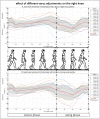The effect of a knee brace in dynamic motion-An instrumented gait analysis
- PMID: 32911488
- PMCID: PMC7482934
- DOI: 10.1371/journal.pone.0238722
The effect of a knee brace in dynamic motion-An instrumented gait analysis
Abstract
Background: Osteoarthritis (OA) is a common problem in the older population. To reduce pain and stress in the affected knee joint compartment, a functional knee brace is often prescribed by physicians to protect it from high loads.
Objectives: An instrumented gait analysis should evaluate how the 4-point knee orthosis for varus or valgus load relief (M.4s OA) changes the kinematics of the knee, especially in the frontal plane.
Methods: 17 healthy participants took part and were analyzed with an inertial sensor system (MyoMotion) giving continuous, objective information on the anatomical angles. The measurements were made both without wearing a knee brace and with the brace in different settings.
Results: The results show a significant reduction in the maximum knee abduction and raised knee adduction. The knee brace, with a strong adjustment in varus or valgus orientation, caused a shift of maximum ab-/adduction in the proposed direction in 69% and 75% of the dynamic tests, respectively. The knee motion in the frontal plane shows individual movement patterns.
Conclusion: The use of the brace leads to significant changes in the knee's movement. Patient-specific movement patterns may explain different effects of functional knee braces on individual persons. Inertial sensors have been shown to be a low-cost, easy-to-use option for individual movement analysis and further personalized therapy.
Conflict of interest statement
The authors have declared that no competing interests exist.
Figures







Similar articles
-
Is valgus unloader bracing effective in normally aligned individuals: implications for post-surgical protocols following cartilage restoration procedures.Knee Surg Sports Traumatol Arthrosc. 2013 Dec;21(12):2661-6. doi: 10.1007/s00167-012-2174-4. Epub 2012 Aug 17. Knee Surg Sports Traumatol Arthrosc. 2013. PMID: 22898913
-
[Effect of Unloading Knee Brace on Dynamic Parameters of the Stance Phase of Gait in Patients with Knee Osteoarthritis].Acta Chir Orthop Traumatol Cech. 2018;85(3):204-208. Acta Chir Orthop Traumatol Cech. 2018. PMID: 30257780 Czech.
-
The effects of a varus unloader brace for lateral tibiofemoral osteoarthritis and valgus malalignment after anterior cruciate ligament reconstruction: a single case study.J Musculoskelet Neuronal Interact. 2013 Dec;13(4):496-500. J Musculoskelet Neuronal Interact. 2013. PMID: 24292620
-
The effect of knee orthoses on gait parameters in medial knee compartment osteoarthritis: A literature review.Prosthet Orthot Int. 2016 Apr;40(2):193-201. doi: 10.1177/0309364614547411. Epub 2014 Aug 26. Prosthet Orthot Int. 2016. PMID: 25160784 Review.
-
The effect of orthotic devices on knee adduction moment, pain and function in medial compartment knee osteoarthritis: a literature review.Disabil Rehabil Assist Technol. 2017 Jul;12(5):441-449. doi: 10.3109/17483107.2016.1151952. Epub 2016 Mar 15. Disabil Rehabil Assist Technol. 2017. PMID: 26980073 Review.
Cited by
-
Effects of Noisy Galvanic Vestibular Stimulation on the Muscle Activity and Joint Movements in Different Standing Postures Conditions.Front Hum Neurosci. 2022 Jun 2;16:891669. doi: 10.3389/fnhum.2022.891669. eCollection 2022. Front Hum Neurosci. 2022. PMID: 35721349 Free PMC article.
-
Running and Jumping After Muscle Fatigue in Subjects with a History of Knee Injury: What Are the Acute Effects of Wearing a Knee Brace on Biomechanics?Bioengineering (Basel). 2025 Jun 16;12(6):661. doi: 10.3390/bioengineering12060661. Bioengineering (Basel). 2025. PMID: 40564477 Free PMC article.
-
Advanced design of 3D knitted padding for wearable cushioning in knee protector.Sci Rep. 2025 Apr 1;15(1):11091. doi: 10.1038/s41598-025-92552-1. Sci Rep. 2025. PMID: 40169672 Free PMC article.
-
Machine Learning Based Abnormal Gait Classification with IMU Considering Joint Impairment.Sensors (Basel). 2024 Aug 28;24(17):5571. doi: 10.3390/s24175571. Sensors (Basel). 2024. PMID: 39275482 Free PMC article.
-
An up to date on clinical prospects and management of osteoarthritis.Ann Med Surg (Lond). 2021 Nov 19;72:103077. doi: 10.1016/j.amsu.2021.103077. eCollection 2021 Dec. Ann Med Surg (Lond). 2021. PMID: 34868573 Free PMC article. Review.
References
-
- Al-Zahrani Y. Effectiveness of a valgus knee brace on biomechanical and clinical outcomes during walking and stair climbing in individuals with knee osteoarthritis. [PhD-Thesis]. Salford, UK: University of Salford; 2014.
-
- Feehan NL, Trexler GS, Barringer WJ. The effectiveness of off-loading knee orthoses in the reduction of pain in medial compartment knee osteoarthritis: a systematic review. J Prosthet Orthot. 2012;24(1):39–49.
MeSH terms
LinkOut - more resources
Full Text Sources

